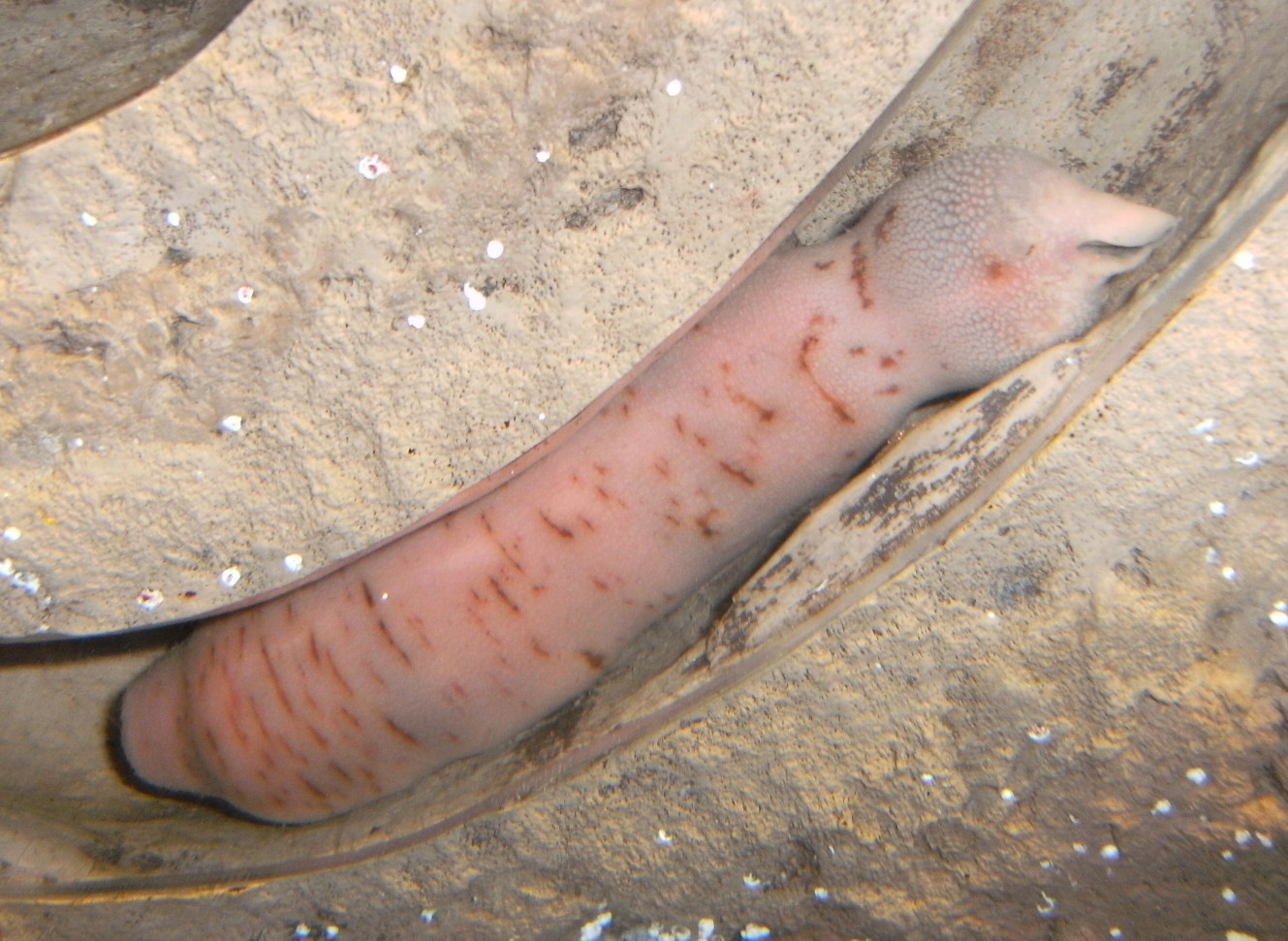Description: Echiuroid worms are round, unsegmented worms that have two setae on the ventral side of the anterior end. This species is cigar shaped, unusually large and fat, plus it has a conspicuous ring of 10-11 setae at the posterior end of its body around the anus. The preoral proboscis is very short. Color is pink. Length to 50 cm (averages 20 cm).
How to Distinguish from Similar Species:
Geographical Range: Southern Oregon to Tijuana Slough, Mexico (may be greater)
Depth Range: Low intertidal to subtidal
Habitat: Permanent burrows in muddy sand
Biology/Natural History: This is the most common Echiuran in California but it does not get quite as far north as Washington State. Most Echiurans directly swallow mud or detritus but this species lives in a permanent U-shaped burrow through which it pumps water, collecting bacteria and other fine particulates on a net of mucus. From time to time it swallows the mucus net along with the attached food. This species often lives in high hydrogen sulfide conditions in the mud. Entrances to the U-shaped burrow are 40 to 100 cm apart and the burrow depth is 10 to 45 cm. The animal pumps water through the burrow by peristalsis of the body. A distinctive pile of castings may be found at the end of the burrow the animal's posterior is facing. The animal accumulates fecal pellets plus burrow excavations near its posterior end in the burrow, then periodically squeezes its body hard to send a blast of water out the anus, blowing the pellets out to form the castings. Many other species may be found sharing the burrow, which is the origin of the name. Species found living in the burrow include the pea crabs Pinnixa franciscana and Scleroplax granulata, the scaleworm Hesperonoe adventor, the clam Cryptomya californica, and one to several individuals of the goby fish Clevelandia ios, which goes in and out of the burrow.
Sexes are separate in this species. Gametes are produced in the coelomic fluid and ejected into the water through modified nephridia. Sperm are white and eggs are pinkish, pale yellow, or pale olive. Larvae are pelagic for about 60 days, then settle. A chemical from the castings of a Urechis burrow is a powerful stimulus to settle.
Predators
include flounders, diamond turbot, leopard sharks (which may suck them
from their burrows), sea otters, and humans (for bait). The
parasitic protozoan Echiurocystis
bullis may be found in the gut.
| Return to: | |||
| Main Page | Alphabetic Index | Systematic Index | Glossary |
References:
Dichotomous Keys:Carlton, 2007
Kozloff, 1987, 1996
General References:
Brusca and Brusca, 1978
Hinton, 1987
Kozloff, 1993
Morris et al., 1980
Niesen, 1994
Scientific Articles:
Arp, A.J., J.G. Menon, and D. Julian, 1995. Multiple
mechanisms provide tolerance to environmental sulfide in Urechis caupo.
American Zoologist 35: pp 132-144
Arp, A.J., B.M. Hansen, and D. Julian, 1992. The burrow environment and coelomic fluid characteristics of the echiuran worm Urechis caupo from three northern California population sites. Marine Biology 113: pp 613-623
Fisher, W.K., 1946. Echiuroid worms of the North Pacific Ocean. Proceedings of the U.S. National Museum 96: pp 215-292
Fisher, W.K. and G.E. MacGinitie, 1928. The natural history of an echiuroid worm (Urechis). Ann. Mag. Natural History (10) 1: pp 204-213
Julian, D., M.L. Chang, J.R. Rudd, and A.J. Arp, 2001. Influence of environmental factors on burrow irrigation and oxygen consumption in the mudflat invertebrate Urechis caupo. Marine Bioloty 139: pp 163-173Menon, J.G. and A.J.Arp, 1993. The integument of the marine echiuran worm Urechis caupo. Biological Bulletin 185: pp 440-454
Newby, W.W., 1940. The embryology of the echiuroid worm Urechis caupo. Mem. American Philisophical Society 16: pp 1-213
Suer, A.L., 1984. Growth and spawning of Urechis caupo (Echiura) in Bodega Harbor, California. Marine Biology 78: 275-284
Web sites:
General Notes and
Observations: Locations,
abundances, unusual behaviors:
In this view of the same individual as above taken a few seconds later, a wave of peristalsis can be seen traveling along the body.
Authors and Editors of Page:
Dave Cowles (2010): Created original page
CSS coding for page developed by Jonathan Cowles (2007)
Rosario Invertebrates web site provided courtesy of Walla Walla University

